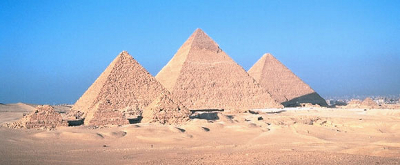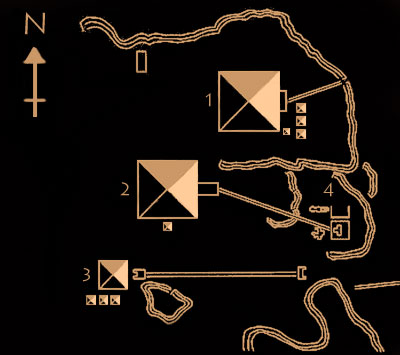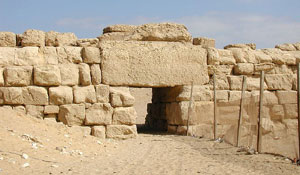The site we now know as Giza (or Gizah) was called Imentet (“the West”) or Kher Neter, (“the Necropolis”) in Ancient Egypt. The pyramids of Giza sit at the top of a limestone cliff which is part of the Middle Eocene Mokattam Formation. The site has not been fully excavated, and even now new tombs are recovered. The site consists of the three large pyramids (including the Great Pyramid), their temples, satellites and storerooms, the Great Sphinx, a worker’s village and a large number of mastabas constructed for wealthy nobles and private citizens.

Royal Tombs
The pyramids of the third dynasty and the early fourth dynasty (Old Kingdom) were built on layers of marl and slate. Although this made digging out underground chambers easier, the marl layers could not support the immense weight of stone above them. This may be one of the reasons that Khufu built his pyramid at Giza rather than Saqqara or Dashur. However, Giza had been a Necropolis for some time before Khufu chose to build there. The First Dynasty (Early Dynastic Period) Pharaoh Djet has a tomb on the edge of the plateau, and seals mentioning the Second Dynasty Pharaoh Ninetjer were discovered in a tomb in the southern cemetery. In fact, Khufu had to clear away earlier tombs in order to construct his pyramid complex.

- The Great Pyramid of Khufu
- Pyramid of Khafre
- Pyramid of Menkaure
- Great Sphinx and Sphinx temples
- Stepped Tomb of Khentkaus I
Even after the ancient Egyptian pharaohs moved away from Giza as their burial site, nobles and officials continued to live and die there. However, during the First Intermediate Period, the pyramid town of Khufu and the cemetery of Giza were both abandoned and left to decay. During the Middle Kingdom, the pyramids and tombs were plundered, and the causeways and temples were used as quarries by the pharaohs of the 12th Dynasty.
Fortunately, many of the New Kingdom pharaohs protected and revered the ancient monuments of Giza, in particular the Great Sphinx (who they called “Lord of Setpet, the Chosen Place”). A number of Eighteenth and Nineteenth dynasty royals erected stelae between its paws and it was worshipped as a representation of the sun god Harmakhet (“Horus in his Western Horizon”). Amenhotep II built a small temple to the deity nearby in which he names the Sphinx Harmakhet -Hauron (Hauron was a Syrian-Palestinian god of the netherworld brought to Giza by settlers living near the Sphinx) and Ramesses II installed a sanctuary between the forepaws of the Sphinx. Restoration was also conducted by the New Kingdom royals, in particular Khaemwaset (a son of Ramesses II) who took a special interest in preserving many of Egypt’s ancient monuments.
By the Late Period, Osiris was the dominant god in the area. He had absorbed Sokar (whose cult was centred at nearby Rostau) and the Sphinx was considered to be his representative. Apparently, huge pedestals were constructed on the Sphinx’s flanks, on which shrines to Osiris and Isis were placed, and Isis gained the epithet, “Lady of the Pyramids”.
Since the demise of the ancient Egyptian civilisation, the site has been quarried to aid the construction of Cairo. Most of the limestone cladding of the pyramids ended up adorning the walls of the city. Even so, Giza remains a massive archaeological site which has not yet been fully excavated and new tombs and buildings continue to be recovered.
Non-Royal Tombs
The skilled workers who live at the site all year round built their tombs near to the pyramids, which was quite an honour. While the tombs are generally made of mud-brick (rather than stone) some used leftover limestone and rubble from the construction of the royal tombs. They employed a number of architectural styles including beehives, small true pyramids and small step pyramids. The majority, however, are mastabas.

Eastern Cemetery
Workers Village
The Egyptians did have slaves (usually prisoners of war or debtors), but the discovery of the workers village at Giza suggests that the pyramids were built by skilled workers and bureaucrats (who lived there all year long) and farmers (who provided seasonal labour during the inundation when they could not work on their farms). The village is about 300 metres south of the Great Sphinx. A 10 metre high wall named ‘The Wall of the Crow’ separates the mortuary complex from the village, with access via a huge gateway with a limestone lintel.

It is thought that as many as 20,000 people may have lived there. Archaeologists found thousands of potsherds dating from the time of the pyramids, along with the remains of buildings for the preparation of the food, supplies, building materials and medical services that the workers required. The settlement also boasts the earliest known paved street, complete with a drainage gully, and the earliest known hypostyle hall (a building with a flat ceiling supported by columns).
Two intact bakeries were discovered, littered with pots, along with a cat-fish processing chamber and a number of copper-working areas. Fragments of wood and ash were found in each of these chambers, showing that even in this early period, the workers were able to obtain a good supply of precious and rare wood from a distant source. Egypt’s bureaucracy was already well developed and efficient.
The worker’s life expectancy was between 30 and 35 years, and both men and women suffered from the effects of their heavy labour. However, the workers also had access to fairly high quality medical care. Surgeons apparently conducted brain surgery, as well as handling fractures and amputations.
Recently, Lehner discovered a series of mud ramps approximately one meter wide, within a series of colonnaded porches which he has suggested acted as a barracks for temporary workers, sleeping up to 2,000 people at once. Chambers to the rear of the barracks were used for the preparation of food, with remains suggesting the workers ate prime beef, bread, and fish, and (of course) drank beer. Lehner also found evidence of a separate workers’ town, to the east which he believes was the home of the skilled workers and officials, and what he hopes is the remains of a royal palace or administrative building. Inside the structure he found evidence of weaving and copper-working and a large court with numerous sunken grain stores.
Bibliography
- Bard, Kathryn (2008) An introduction to the Archaeology of Ancient Egypt
- Kemp, Barry J (1991) Ancient Egypt: Anatomy of a Civilisation
- Lehner, Mark (1997) The Complete Pyramids
- Malek, Jaromir (2000) “The Old Kingdom”, in The Oxford History of Ancient Egypt Ed I. Shaw
- Van De Mieroop, Marc (1999) A History of Ancient Egypt
- Verner, Miroslav (2001) The Pyramids
- Wilkinson, Richard H. (2000) The Complete Temples of Ancient Egypt
- Wilkinson, Toby (2010) The Rise and Fall of Ancient Egypt
Copyright J Hill 2008